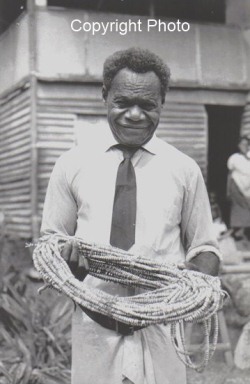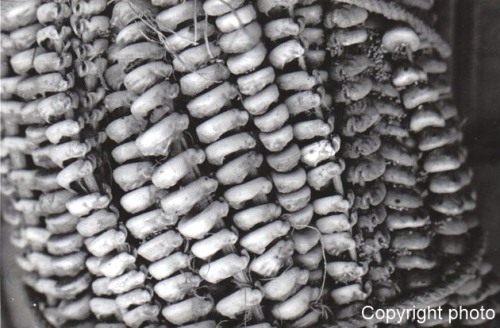
PNGAA Library
Some notes on the traditional shell money (and other currencies) of the Gazelle Peninsula: Maxell R Hayes

 On arriving in Rabaul in 1959 my wife and I were quickly introduced to the local currency, particularly at the native markets, and found it to be known as ‘tambu’ or sometimes as ‘tabu’. In July 1965, I was asked by Eliakim Touvana Toposa [see photo], an elderly former luluai (government appointed official) of Lunga Lunga village about 20 km from Rabaul on the north coast road, to photograph his immense holdings of this form of currency which made him a wealthy man. Then a Councillor of the Gazelle Peninsula Local Government Council, he lived in a substantial house, ran two trucks and had interests in copra and cocoa plantations. He was born in 1904 during the German administration. His wealth in tambu alone then was estimated at about Au$6,000.
On arriving in Rabaul in 1959 my wife and I were quickly introduced to the local currency, particularly at the native markets, and found it to be known as ‘tambu’ or sometimes as ‘tabu’. In July 1965, I was asked by Eliakim Touvana Toposa [see photo], an elderly former luluai (government appointed official) of Lunga Lunga village about 20 km from Rabaul on the north coast road, to photograph his immense holdings of this form of currency which made him a wealthy man. Then a Councillor of the Gazelle Peninsula Local Government Council, he lived in a substantial house, ran two trucks and had interests in copra and cocoa plantations. He was born in 1904 during the German administration. His wealth in tambu alone then was estimated at about Au$6,000.
Of all the various varieties of shells used as money by indigenous natives of the Pacific, one of the smallest would be the rock snail of New Britain. Throughout PNG larger sea shells such as the trade store item the white egg cowrie (ovula ovum), the large gold lip pearl oyster ‘kina’ (pinctada maxima; from which the 1975 PNG currency takes its name) and the much rarer golden cowrie (cypraea aurantium) were to be seen, along with the common shell arm ring laboriously fashioned from the giant clam (tridacna gigas) worn by males, all of which could not be regarded as currency but largely as adornment.
Compared with those we have the almost minute rock snail (nassarius arcularis jonasii) which grew to a maximum length of about 15 mm. It also abounds in other areas of New Britain, Bougainville, New Ireland and the Admiralty Group, in which villagers show little or no interest as a form of currency. Living in abundance in the shallow waters around the Nakanai area of the north coast of New Britain the collection of this shell provided a lucrative livelihood for villagers. Shells when collected contained a small living mollusc which was removed by boiling or by burying for weeks to allow ants to dispose of the flesh and then sold through the medium of Chinese traders for about Au$3.00 per small tin to Gazelle Peninsula Tolais. The women then methodically removed the top of this tiny shell by placing it in the eye of a coconut shell and prising the top off by means of a knife. The residue, or mouth, of the shell was then threaded onto a freshly cut thin length or rattan cane to about 75 shells per 30 cm, boiled with native roots and left to fade after becoming reddish in colour. The usual length was a param (pidgin; a fathom in nautical terms) or pokono (Tolai gunantuna or kuanua language) generally regarded as the length between outstretched fingertips of an adult male of approximately six feet or a little less than two metres and should contain about 320 shells. Many such lengths were spliced together into a continuous length and rolled into great hoops about 2 metres in diameter (Tolai: loloi) consisting of between 100 and 300 (or sometimes more) param or smaller hoops of about 30 cm in diameter, or they have remained in single param lengths to be bagged in native material (usually banana or pandanus leaf) and slung onto a pole, placed in baskets or with smaller amounts carried in pouches. Smaller lengths of up to about 3 to 10cm were commonly seen in markets particularly used to purchase betel nut (buai) (Areca catechu) from the abundant betel nut palms, the pepper vine bean (daka) (Piper betel) and small bags of powdered white lime (pidgin: kambung) (hydrated calcium oxide) obtained by burning dried coral, the psychoactive ingredients commonly used to get a ‘high’ (causing the familiar red mouth which often led to cancers of the mouth and oesophagus) before and after drinking alcohol became legal on 2 November 1962 for PNG indigenous citizens. The bean was dipped, by males and females alike, in small bags of lime and chewed with the betel nut, with the red residue later spat out, a sight many would be well familiar with along with the smiling stained blacked teeth of the users.
 Tambu, also known as diwarra at the adjacent Duke of York Islands and on New Ireland, played a very important part in the life of Tolai villagers being used for settling disputes and ‘payback’, bartering for produce, as part or the whole of the traditional ‘bride price’ as well as being regarded as a symbol of prestige, and along with goods and cash was the customary method of acquiring land. Usually, older male Tolais had acquired some holdings of tambu, which, on a man’s death, was distributed to relatives and friends in accordance with one’s status who came to mourn the deceased, accompanied by much feasting and wailing. Large amounts of tambu were usually kept in a special tambu house (Tolai: a pal na vuvuvung).
Tambu, also known as diwarra at the adjacent Duke of York Islands and on New Ireland, played a very important part in the life of Tolai villagers being used for settling disputes and ‘payback’, bartering for produce, as part or the whole of the traditional ‘bride price’ as well as being regarded as a symbol of prestige, and along with goods and cash was the customary method of acquiring land. Usually, older male Tolais had acquired some holdings of tambu, which, on a man’s death, was distributed to relatives and friends in accordance with one’s status who came to mourn the deceased, accompanied by much feasting and wailing. Large amounts of tambu were usually kept in a special tambu house (Tolai: a pal na vuvuvung).
Missionaries and traders in the Gazelle Peninsula documented use of the tambu as a currency in well established usage by the mid 19th century. Later the German Imperial Government tried to ban its traditional use by allowing access to the then German New Guinea mark and pfennig to Tolais and allowing them to open bank accounts but failed. Its usage continued through the Australian era of sterling and decimal currency, the period of Japanese occupation and now ranks unofficially alongside the kina. Naturally it is not quoted on international money markets.
In the early 1960s, the official rate of a param was 2/- or later as 20c, but such was the importance attached to it as a symbol of prestige that the effective valuation placed it at £1.0.0 or later as Au$2.00. In 1968, the Gazelle Local Government Council passed a rule that the ‘bride price’ should be no more than 100 param of tambu or Au$300.
Alongside the PNG monetary system of kina and toea introduced in 1975, tambu is still highly valued. In the Gazelle Peninsula in 2001 the provincial government accepted the payment of taxes and local courts award restitution and settlement of disputes, etc, in tambu. In February 2002 a ‘Tolai Exchange Bank’ commenced exchanging tambu into PNG currency at the rate of 4 Kina per param. Circulation of shell money then had an estimated value of K8,000,000.
PNG people have little faith in banks (and who can blame them). I well remember the Saturday morning bank queues in Rabaul, when locals would come in and present pass books, withdraw their deposit in the TNG or Australian shillings, count it, and then redeposit. On one occasion our house boy showed us some old gold German New Guinea 10 mark coins asking if these would be still ‘good’ when our new decimal currency was introduced on 14 February 1966. Knowing nothing about these old coins, we told him, ‘we suppose so’ so he reburied them in his village at Natamanai along with many others, where they may still well be. With later knowledge we could have been sitting on a rare fortune if we had some appreciation of the value of gold German currency.
 I recall having seen in fairly common usage the ‘fuse’ (a name literally appertaining to a plug of dynamite) consisting of a tightly rolled stack of 100 shillings to the value of £5.0.0. The first TNG currency of a penny and a halfpenny was introduced in 1929 (these two coins now being exceedingly rare and now worth many thousands of dollars) and in 1936 another issue of a 1d, 3d, 6d and 1/- (8,875,000 were minted in sterling silver with many millions later melted down into silver bullion). I once saw a large flour drum full of the TNG shillings owned by a senior police officer in the Commonwealth Bank vault. The interesting thing was that he had persuaded the bank to regard this bullion as a bank deposit and pay him interest on.
I recall having seen in fairly common usage the ‘fuse’ (a name literally appertaining to a plug of dynamite) consisting of a tightly rolled stack of 100 shillings to the value of £5.0.0. The first TNG currency of a penny and a halfpenny was introduced in 1929 (these two coins now being exceedingly rare and now worth many thousands of dollars) and in 1936 another issue of a 1d, 3d, 6d and 1/- (8,875,000 were minted in sterling silver with many millions later melted down into silver bullion). I once saw a large flour drum full of the TNG shillings owned by a senior police officer in the Commonwealth Bank vault. The interesting thing was that he had persuaded the bank to regard this bullion as a bank deposit and pay him interest on.
The word ‘tambu’ is not exclusive to the Tolai language and appears in the Pidgin English dictionary of John Murphy (1943-1962 eds) and the dictionary of Neo-Melanesian (Mihalic (1957). The main thrust of the word is to mean ‘forbidden’; however it also refers to ‘brothers and sisters-in law’, relatives whose name may not be mentioned, may be used as a friendly term of address or when referring to the Bible ‘Buk Tambu’, and so on.
Reportedly in 2009 during the world global financial crisis and the devaluation of the kina, the tambu also depreciated, but, none the less, is very commonly in use in the 21st century. So, is the tambu to be replaced by plastic credit cards, or the kina. I think not.
Sources available on file. ▪